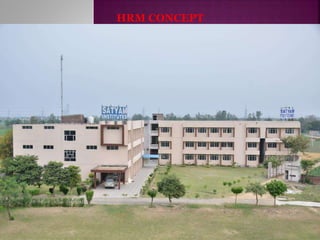Hrmclassppt 120517090901-phpapp02
- 2. Human resource management is concerned with the development and implementation of people strategies, which are integrated with corporate strategies, and ensures that the culture, values and structure of the organization, and the quality, motivation and commitment of its members contribute fully to the achievement of its goals. Definition: HRM is the process of acquiring, training, appraising, and compensating employees, and of attending to their labor relations, health & safety, and fairness concern.
- 3. With the advent of resource centric organizations in recent decades, it has become imperative to put “people first” as well as secure management objectives of maximizing the ROI (Return on Investment) on the resources. This has led to the development of the modern HRM function which is primarily concerned with ensuring the fulfillment of management objectives and at the same time ensuring that the needs of the resources are taken care of. In this way, HRM differs from personnel management not only in its broader scope but also in the way in which its mission is defined. HRM goes beyond the administrative tasks of personnel management and encompasses a broad vision of how management would like the resources to contribute to the success of the organization.
- 4. Human Resources are heterogeneous.(Different people, different personalities, different needs, attitudes and values). Human resources are dynamic and behave differently.(They react to the same situation in quite different ways). HR are the most important element in an organization. The effective utilization of all other resources depend upon the quality of HR. The term HR is wider than the term Personnel. HR include all dynamic components of all the people at all levels in the organization, whereas personnel means the employees working in the organization.
- 5. To help organization attain its goals by providing well trained and well motivated employees. To employ the skills and knowledge of employees efficiently and effectively, i.e., to utilize HR effectively. To enhance job satisfaction of employees by encouraging and assisting every employee to realize his full potential. To establish and maintain productive, self-respecting and internally satisfying working relationship among all the members of the organization. To bring about maximum development of individuals by providing opportunities for training and development. To maintain high morale and good HR within the organization. To help maintain ethical policies and behavior inside and outside the organization. To recognize and satisfy individual needs and group goals by offering appropriate monetary and non-monetary incentives.
- 6. As managers none of us would like to make the following mistakes: To hire the wrong person for the job. To experience high turnover . To find our people not doing their best. To waste time with countless and useless interviews. To be quoted under bad example of unsafe practices. To have some of your employees think their salaries are unfair and inequitable relative to others in the organization. To allow a lack of training to undermine your department's effectiveness To commit any unfair labor practices .
- 7. The Industrial Revolution Trade Unionism Scientific Management Industrial Psychology HR Movement Behavioral Science Employee Welfare
- 8. The Industrial Revolution: Development of Machinery, Linking power to machines, establishing factories etc. Trade Union: Workers formed their unions to improve their lots so that management could be forced to redress grievances. Scientific Management: F.W. Taylor: (a) development of a true science.(b) Scientific selection and training of workers.(C) Friendly cooperation between management and workers.(d) Development of every worker to hid fullest potential. Industrial Psychology: It stressed on matching of employees skills with job. Contributions made to analyze the jobs in terms of their mental and emotional requirement and development of testing devices. HR Movement: Researches focused on the attitude and feelings of workers and their influence on productivity. The role of informal groups in industry were highlighted. It was suggested that interpersonal relationships should be improved.
- 9. Behavioral Science: Research in anthropology , sociology, psychology, etc. has provided the subject matter for HRM. Behavioral Science era led to the development of new techniques of motivation and leadership e.g., employee participation, 2 way communication, management by objectives etc. Employee welfare: With the dawn of welfare era, scope of HRM increased. It is not only concerned now with recruitment, selection, and training of employees. It manages employee benefits programmes and industrial relations system in industry.
- 13. Job Analysis Recruitment Separation Induction Promotion Transfer HR Planning Selection Placement
- 14. Performance Appraisal Executive Development Training Career Planning & Development
- 15. Job Evaluation Bonus & Incentives Wage & Salary Administration Payroll
- 16. Motivation Grievance Redressal Job Satisfaction Collective Bargaining Conflict Management Employees’ Partiicipation Discipline
- 17. Health Social Security Safety Welfare Schemes HR Records HR Research HR Audit
- 18. Direct Financial Compensation - Pay that person receives in form of wages, salaries, bonuses, and commissions. Indirect Financial Compensation (Benefits) - All financial rewards not included in direct compensation such as paid vacations, sick leave, holidays, and medical insurance. Nonfinancial Compensation - Satisfaction that person receives from job itself or from psychological and/or physical environment in which person works.
- 19. It is concerned with protecting and promoting the physical and mental health of employees. For this , several types of fringe benefits such as housing, medical aid, educational facilities, conveyance facilities etc. are provided. Social security measures are provided such as; PF, Pension plans, gratuity, maternity benefits disablement allowances, group insurance etc.
- 20. Strategic HRM Creating High-Performance Work system Managing technology

